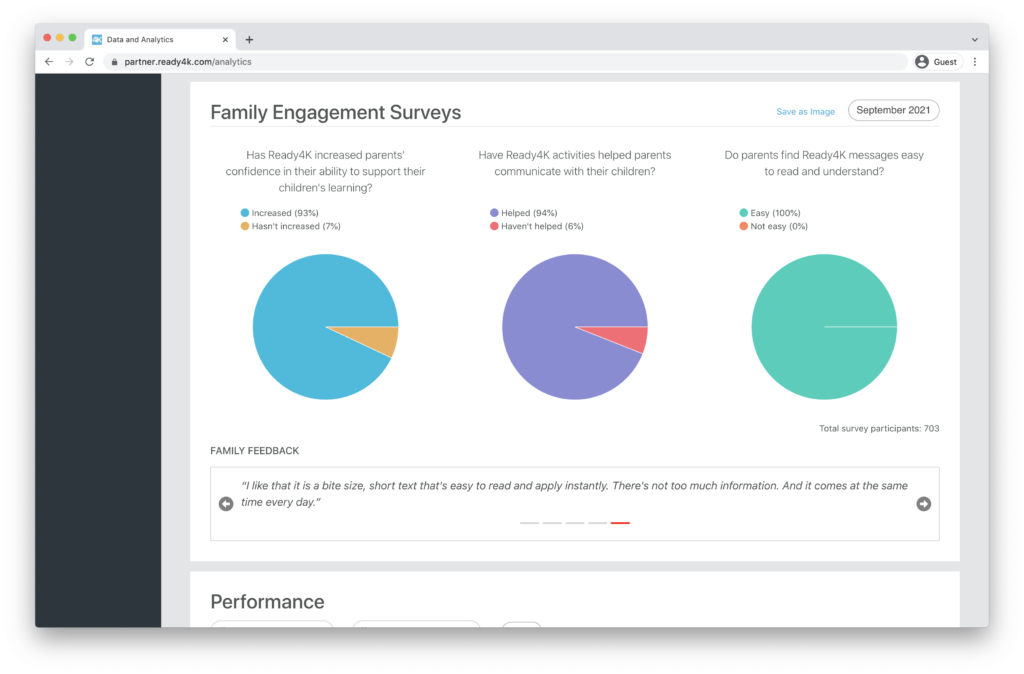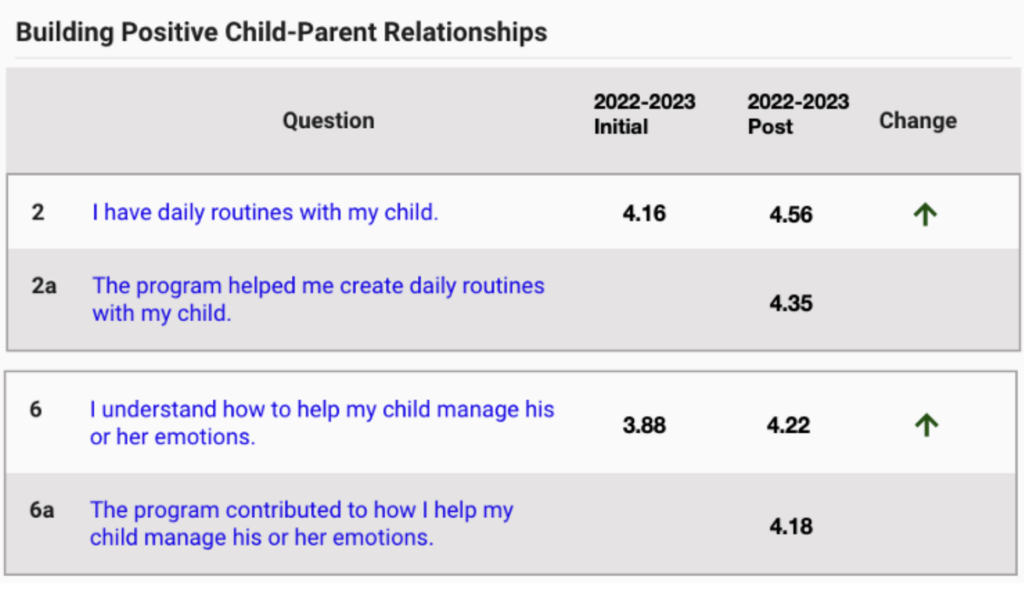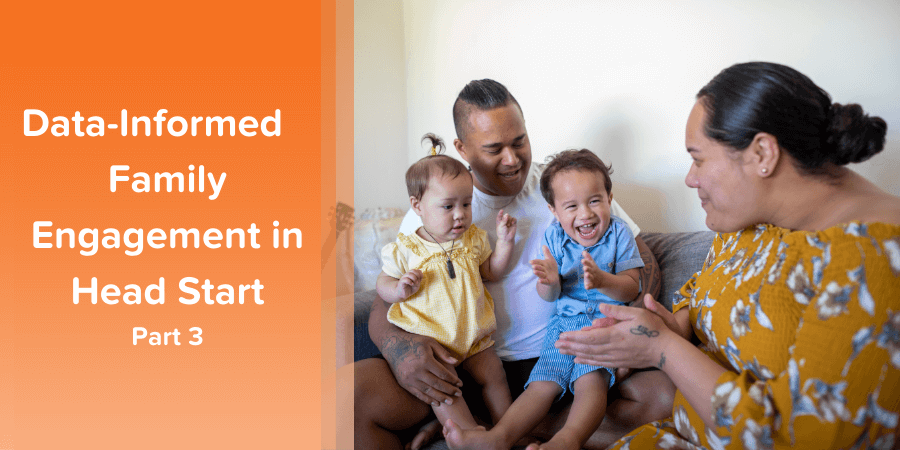By Maren Madalyn, contributing writer
This post is Part 3 of a series exploring how to use PFCE data-informed approaches to increase the efficacy of Head Start family engagement strategies and other services in early childhood programs. You can read Part 1 here and Part 2 here. Watch our recent webinar with the National Head Start Association about how Parent Gauge and ParentPowered Trauma-Informed combine to create powerful family engagement!
Strengths-based partnerships with families are essential for positive developmental and learning outcomes for children. Parents, caregivers, and guardians are a child’s first educators, and early childhood professionals need these crucial stakeholders to cultivate children’s well-being. The most effective Head Start family engagement strategies ensure family’s biggest needs are met — and their greatest strengths are leveraged.
In Part 1 of our series, we unpacked why a data-informed approach is extra powerful for designing meaningful family and community engagement. In Part 2, we explored how an imaginary Head Start program assesses family needs and plans data-driven, coordinated family engagement strategies based on these crucial inputs.

In Part 3, our imaginary Head Start program turns its attention to maintaining positive and goal-oriented relationships with their families. By collecting family feedback, analyzing resource usage, and revisiting their PFCE data, this program introduces small, incremental changes to their family education programs — measuring their progress on child and family outcomes along the way. Using Parent Gauge and ParentPowered Trauma-Informed together helps Head Start program teams drive this process, ensuring the right support at the right time for families all year long.
Maintaining momentum in Head Start family engagement efforts
Let’s return to where we left off with our imaginary Head Start program.
The year is humming along, and everything seems to be going well so far. You have successfully mapped out your program’s game plan for the year. You’ve used your PFCE data about family needs and strengths to organize the most crucial program services needed for your families. You’ve filled a calendar with caregiver and parent involvement opportunities that cover their specific needs. You’ve identified the core community and program resources to deliver to your families, with an emphasis on effective reading strategies, communication, and other high-need areas revealed in your data.

But now the question is — have your families’ needs around literacy and communication shifted from the start of the school year? Are there measurable improvements to children’s school readiness skills in these areas? What support are your families looking for today?
In a data-informed approach to Head Start family engagement, your team monitors the impact of its education programs throughout the year — and this is where continuous improvement comes into play.
Monitor program impact and identify emergent needs
If you’re using a tool like ParentPowered Trauma-Informed to provide trackable support for families, you have several monitoring features at your disposal. These tools help you understand the effect of your Head Start programming and how family needs may have shifted throughout the year. For each curated community resource you’ve shared with families over text, your staff can see how many families have clicked and engaged with it in your ParentPowered dashboards. This data acts as a compass, pointing your team toward the kinds of resources that your families may seek or need.
Here’s one way you can use this data to monitor your Head Start family engagement programming. During a recent monthly data review, your program staff observed that, among the resources delivered to families, the most downloaded resources were not about literacy at all. In fact, parents largely clicked on resources focused on social-emotional skills, specifically calm-down strategies.

Surprised, your team examines additional PFCE data and discovers that your recent family workshop about managing big emotions in little learners was well attended — the most well-attended parent event thus far in the year! Now that your team recognizes that these families’ needs have evolved, you can consider refocusing upcoming workshops or engagement opportunities on emotional regulation and other related topics.
Recalibrate Head Start services to support families
Before recalibrating your program, however, you can use ParentPowered survey tools to test this hypothesis. Your team already has access to the results of quarterly family engagement surveys that collect feedback from your parents and caregivers via text. The quantitative and qualitative data from these surveys also guide your Head Start program to understand how your offerings have helped families so far and where might opportunities for improvement lie.
ParentPowered also gives your program staff tools to send custom messages and surveys via text to your families throughout the year as needed. That way, your team can quickly collect specific family input — such as their interest in emotion regulation resources — in order to adjust upcoming family engagement events or community resources to highlight.

But it gets better. Though simple, these quick polls are an easy opportunity for ongoing partnership that also create mutual respect and trust between your program staff and the parent community. By giving families a voice in program designs and offerings, your team emphasizes the value of parent involvement — deepening your partnerships with families little by little.
Turning back to our example, your team taps into its relationships with families to validate this hypothesis about family needs, sending a quick interest poll to families about social-emotional learning topics. As responses come back, you quickly see immense interest in both calm-down strategies and adult self-care resources. With this emergent family need verified, your team sets to work shifting next month’s family engagement calendar.
By combining your families’ feedback and PFCE data with other sources like attendance rates, your Head Start program team gains a snapshot of what your families need, how those needs are changing, and how your programming is or is not meeting families’ current needs — at any time during the school year. From there, your team can then recalibrate your family engagement efforts through iterative adjustments that better support each of your families.
Reassess, reflect, and start again!
Let’s fast forward one last time — all the way to the end of the program year.
The family engagement calendar is winding down to a close, and you and your families are gearing up for summer. Your Head Start program team made iterative changes to family engagement programs in response to new challenges and desires expressed by your families. In the last program month, your staff comes back together once more to take stock of the overall impact made on student learning and family well-being this year. In other words, it’s time to reflect and reassess.
If your program uses Parent Gauge, your staff has conducted their follow-up strengths and needs assessment with each family. As a team, you explore how family responses to these evidence-based questions have changed since the start of the program year. The side-by-side comparison of results for each question helps your team quickly identify the benefits of family engagement conferred to families, and what opportunities for improvement to community engagement lie ahead.
Your team also holds a collective reflection on the program overall. Your staff shares what successes the team witnessed in parent-child relationships, developmental outcomes for children, and highlights from family and community engagement events. Team members also identify ongoing challenges your families and staff continue to face.

Here are a few guiding questions to help your Head Start program reflect at the end of the program year:
- What resources were most downloaded by families throughout the school year?
- Which family workshops were most well attended by families? Was there a difference in attendance between virtual and in-person events?
- Which families did not engage in our programs? How can we design future engagement opportunities to ensure they can participate?
- What support do families still crave? How can we or our community partners provide that support during the summer months?
- Are there new PFCE efforts that our team wants to undertake next year to deliver even more value to families?
Triangulating anecdotal reflections, incremental ParentPowered family input, and the end-of-year PFCE data collected, your staff paints a comprehensive picture of how your family engagement efforts benefited your community and impacted family outcomes over time.

Of course, this journey doesn’t stop here. Your year-end program analysis is critical to informing changes for next year — and even ways that your program can continue to support families with learning activities throughout the summer months (using ParentPowered or other family support tools). Your staff can also leverage this feedback to plan ahead and prepare to re-enter the research stage with greater clarity and focus.
Data-informed Head Start family engagement benefits everyone
Continuous improvement is core to a data-driven approach to Head Start family engagement. Family inputs aligned with the PFCE framework are just the beginning to crafting a Head Start program year filled with high-quality educational services and events for families. Ultimately, a data-informed family support program is all about ongoing, reciprocal relationships with families, centered on positive family and child outcomes. In fact, this is the crux of family engagement in education at all levels.
By leveraging the right PFCE data and text-based family support throughout the school year, Head Start programs better respond to family needs as they evolve and concentrate their efforts on the strategies that make the greatest impact. This collaboration gives every child the best possible opportunity to thrive — and both Parent Gauge and ParentPowered Trauma-Informed empower Head Start programs to do just that!

About the author
Maren Madalyn has worked at the intersection of K12 education and technology for over a decade, serving in roles ranging from counseling to customer success to product management. She blends this expertise with fluid writing and strategic problem-solving to help education organizations create thoughtful long-form content that empowers educators.







